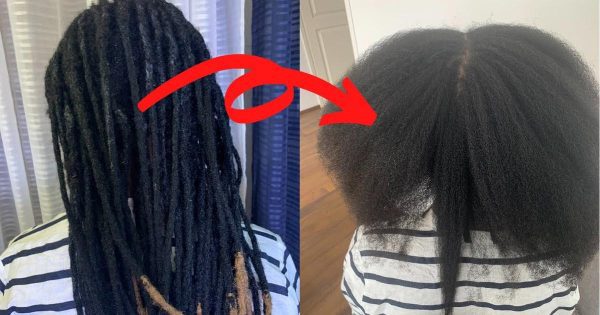
Removing dreadlocks can be a liberating and exciting experience, opening the door to new styling possibilities and reconnecting with your natural hair texture. However, the hair after removing dreadlocks also requires specific care and attention to help it adjust and thrive.
Understanding The Transition
Dreadlock removal frequently results in hair loss and breaking, particularly with some hair types because of their delicate and entwined strands. The length of each locust and individual hair can cause a change in hair texture, resulting in straighter, curlier, or drier hair. Because the hair underlying the dreadlocks is in a different growth stage, new growth beneath them may result in inconsistent length and texture.
Transitioning from dreadlocks involves embracing your natural hair texture, embracing its unique curls, coils, waves, or straight strands. To get rid of buildup and residue, start by washing your hair with a clarifying shampoo and moisturizing conditioner. Try a variety of twist-outs, braid-outs, and wash-and-go styles to bring out the natural texture of your hair. Take advantage of your hair’s versatility by trying out different looks and haircuts.
How To Care For Your Hair After Removing Dreadlocks
Here’s what you need to know about caring for your hair after removing dreadlocks.
Clarifying and Cleansing
Clarify and completely wash your hair to begin your post-dreadlock hair care regimen. To get rid of any build-up or residue from your dreadlocks, use a clarifying shampoo. Use a hydrating wash afterwards to replenish your hair and scalp.
Deep Conditioning Treatment
Give your hair a deep conditioning treatment to bring back its hydration and vibrancy. To effectively penetrate the hair shaft and restore moisture, apply a hair mask or conditioner that is nourishing and rich, and keep it on for a considerable amount of time.
Trimming and Styling
To get rid of any damaged ends or uneven lengths, think about getting a trim. This will revitalize your hair and encourage healthy hair development. Try a variety of hairstyles and textures to see how beautiful and adaptable your natural hair can be.
Moisturizing and Sealing
Use a moisturizing lotion or leave-in conditioner daily to keep your hair hydrated. Your hair tends to be drier at the ends and lengths, so pay attention to those areas. To stop moisture loss and lock in hydration, seal in moisture using a natural oil like jojoba or coconut oil.
Gentle Detangling
Gently untangle your hair using your fingers or a wide-tooth comb. Making sure not to break or harm your hair, begin at the tips and work your way up to the roots, removing any knots or tangles.
Protective Styling
Adopt preventive styling techniques to reduce manipulation and shield your hair from harm. Choose low-tension hairstyles like buns, twists, or braids; stay away from looks that strain or pull on hair follicles.
Patience and Persistence
As your hair becomes used to its new length and texture, have patience with it. Your natural curl pattern might not show up right away, so enjoy the ride and mark each accomplishment as it happens.
Regular Maintenance
Make sure you wash, condition, and moisturize your hair regularly as part of your hair care regimen. To maintain healthy, vibrant hair, pay attention to what your hair requires and modify your regimen accordingly.
Frequently Asked Questions and Answers About Hair After Removing Dreadlocks
1. How long does it take for my hair to recover after removing dreadlocks?
The recovery time varies depending on factors such as hair type, length of time with dreadlocks, and the condition of your hair. Generally, it may take several months to a year for your hair to fully recover and return to its natural state.
2. Will my hair be damaged after removing dreadlocks?
While some hair breakage or thinning may occur during the removal process, proper care and maintenance can minimize damage. With patience and the right techniques, you can help your hair recover and thrive after removing dreadlocks.
3. Should I cut my hair after removing my dreadlocks?
Trimming your hair after removing dreadlocks can help remove any damaged ends and promote healthy hair growth. However, it’s not always necessary, and the decision to cut your hair depends on your personal preferences and hair goals.
4. How do I deal with the new texture of my hair after removing dreadlocks?
Embrace the natural texture of your hair after removing dreadlocks by experimenting with different hairstyles and products. Be patient as your hair adjusts, and consider seeking advice from a hairstylist or hair care professional for guidance on styling and maintenance.
5. How do I prevent my hair from forming new dreadlocks after removal?
To prevent new dreadlocks from forming, maintain a regular hair care routine that includes washing, conditioning, and moisturizing your hair regularly. Avoid hairstyles that promote tangling or matting, and use lightweight products to keep your hair moisturized and manageable.
6. What products should I use for my hair after removing dreadlocks?
Choose products specifically formulated for your hair type and needs, such as moisturizing shampoos, conditioners, and styling products. Look for products that are free of sulfates, parabens, and silicones to keep your hair healthy and nourished.
7. Can I style my hair immediately after removing dreadlocks?
While you can style your hair after removing dreadlocks, it’s essential to be gentle and avoid applying excessive tension or heat to prevent further damage. Opt for low-manipulation hairstyles and use protective styling techniques to promote hair health and recovery.
8. When should I seek professional help for my hair after removing dreadlocks?
If you experience significant hair breakage, scalp irritation, or other concerns after removing dreadlocks, consider seeking professional help from a hairstylist. They can assess your hair’s condition and provide personalized advice and recommendations for care and treatment.
Conclusion
Dreadlock removal is the start of a new chapter in your hair journey, one that will allow you to embrace and rediscover your natural hair texture. Time and effort are also required for recovery following dreadlock removal. By following the steps and tips outlined in this blog post, you can care for your hair after removing dreadlocks and embrace the beauty and versatility of your natural hair with confidence and pride. As you go out on this thrilling new journey, keep in mind to be patient, kind, and aware of your hair’s demands.

Leave a Reply